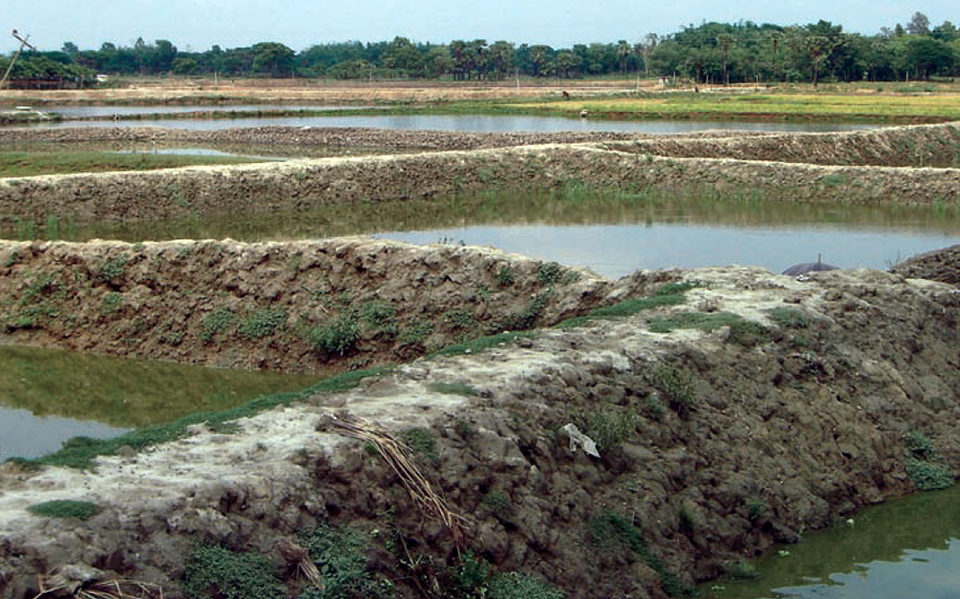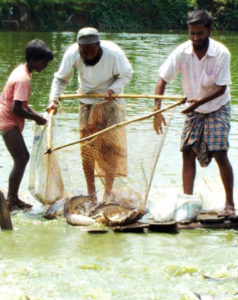Farmer survey cites high feed and seed costs, lack of credit

Pangasius hypophthalmus is an indigenous fish species of Thailand that has spread to Vietnam, Malaysia, Indonesia, China, and other countries. Locally known as pangus, it was introduced in Bangladesh in 1989. Although most of the country’s freshwater production is devoted to the polyculture of carps, there is great potential for increased pangus culture in Bangladesh, which has adequate climate, water, and soil conditions for the fish.
Pangus are profitable because of their year-round production, quick growth and high productivity. The fish can be stocked in ponds at a much higher density than other species.
Local market demand is significant because of low market price. Most poor people consume pangus, and a large number of rural people who live below the poverty line find employment in production and marketing systems for the species.
Case study

The authors recently surveyed pangus farmers and associated groups in a case study carried out as part of the United Nations Food and Agriculture Organization’s Inland Fisheries and Aquaculture Service program. The primary study area was Bhaluka upazila, Mymensingh district, in the north-central part of Bangladesh. The area is an important area for pangus farming due to the availability of hatchery-produced fry and commercial pelleted aquafeeds, as well as favorable socioeconomic conditions.
A combination of participatory, qualitative, and quantitative methods was used for data collection from October 2005 to February 2006. Ten two-hour focus group sessions were conducted with six to 12 persons in each session. A total of 60 farmers participated in questionnaire interviews at their homes and/or farm sites that focused on farming systems, production technology, productivity, constraints, livelihood outcomes and other topics.
Pangus production
The livelihoods of a large number of small and marginal farmers are associated with pangus production in Bhaluka upazila. Before pangus farming, most farmers were involved in fry rearing, tilapia farming, integrated rice-fish farming, and other activities. Few were involved in carp polyculture due to the area’s low soil fertility. Ninety percent of the respondents said they produced pangus because of its profitability, although few farmers cultured for their own consumption.
All interviewed farmers practiced pangus monoculture in the study area. The peak farming season was March to December/January. Most farmers stocked their ponds March to May and harvested at three-month intervals until the end of the year. Farmers practiced intensive, semi-intensive, and traditional culture.
Survey results showed that 87 percent of households had a single pond, and the rest had two ponds. Average pond area was 0.23 hectares (ha). Farmers relied on rainfall and ground water from tube wells for pangus farming.
Since pangus productivity is closely related to feed inputs, supplementary feeds were used by all farmers. Average feed use was estimated at 13,723 kg/ha/year. Pangus farms based on traditional feeding practices generally used a mixture of locally available ingredients, such as rice bran, wheat bran, and oil cake. Intensive farms depended on commercially manufactured pelleted feeds, while some semi-intensive farms made a mixture of feed comprised of rice bran, wheat bran, oil cake, fishmeal, flour, dried fish, oyster shell, salt, and vitamins.
Regardless of farming system, the average annual stocking density of fingerlings was estimated at 23,847 per ha. Most respondents reported multiple stocking, while a few traditional farmers stocked once per year. Little pond management involving removal of aquatic weeds and predatory fish, and other measures was undertaken before stocking.
Most farmers used fertilizers to promote natural food such as phytoplankton and zooplankton. About 60 percent of the farmers used cow dung as a fertilizer, 57 percent used urea, and 43 percent used triple super phosphate (TSP) at varying frequencies (Table 1).
Ahmed, Inputs and returns from pangus farming, Table 1
| Mean | Standard Deviation |
|---|
Mean | Standard Deviation | |
|---|---|---|
| Inputs | ||
| Stocking (fish/ha/year) | 23,847 | 6,578 |
| Feeding (kg/ha/year) | 13,723 | 4,892 |
| Fertilization – Cow dung (kg/ha/year) | 903 | 241 |
| Fertilization – Urea (kg/ha/year) | 259 | 89 |
| Fertilization – Triple super phosphate (kg/ha/year) | 192 | 56 |
| Output | ||
| Productivity (kg/ha/year) | 8,343 | 3,231 |
| Feed-conversion ratio | 1.64 | 0.41 |
| Cost Analysis | ||
| Production cost (U.S. $/ha/year) | 2,964 | 853 |
| Gross revenue (U.S. $/ha/year) | 5,134 | 1,761 |
| Net return (U.S. $/ha/year) | 2,170 | 696 |
Average annual yields of pangus were estimated at 8,343 kg per ha – much higher than for carps, which in the greater Mymensingh area averaged 3,300 kg per ha. Responses concerning the reasons for the increased pangus productivity included an increased supply of feed and quality fry, maintenance of water quality, disease control, and better overall pond management.
Supply chain
The domestic pangus supply chain from farmers to consumers encompasses primary, secondary, and retail markets that involve sales agents, suppliers, wholesalers, and retailers. Many poor rural people are involved as local agents, traders, intermediaries, day laborers, and transporters.
In general, trucks and pickups transport the live fish to market in water-filled plastic containers. The fish are traded whole, ungutted, and fresh without processing. Price depends on quality, size, weight, seasonality, market structure, supply and demand, and taste. The average farm gate price was estimated at the equivalent of U.S. $0.62 per kg.
Other survey findings
Survey respondents said they built culture skills through their own knowledge and in some cases through technical assistance from the Danish International Development Agency-funded Mymensingh Aquaculture Extension Project. The questionnaire interviewees had an average of 5.6 years of experience in pangus farming. Most farmers were young, ranging 29 to 50 with an average age estimated at 39. Among the surveyed group, the illiteracy rate was reported as 58 percent.
The average annual net return from pangus farming was estimated at $2,170/ha (Table 1). Almost all respondents reported this as their primary occupation and their major source of income. Seventy percent of the farmers used their own money for pangus farming, while the rest received small loans from money lenders, fish traders, nongovernmental organizations, or banks. The average annual credit received by farmers was estimated at $220.
Pangus-farming communities are often disadvantaged due to poor roads and transportation facilities, poor market infrastructure, insufficient ice supplies, and lack of electricity. Most farmers lived in houses made of mud, bamboo, and paddy straw. Friction between disadvantaged and wealthier farmers reportedly sometimes led to scuffles involving villagers. Fish poaching and pond poisoning were reported to be significant in the study area.
Constraints
Although pangus farming plays an important role in the economy of rural Bangladesh, concerns have risen about high production costs for feed and seed and lack of credit. The livelihoods of pangus farmers and associated groups are additionally affected by natural disasters, seasonality, community conflicts, fish diseases and political and economic trends.
Limited institutional and administrative help, and inadequate extension services have been major constraints to the sustainable development of pangus farming in Bangladesh. Both nongovernmental organizations and private entities have not played much of a role in the development of the industry. Current needs include technical assistance, low-interest credit, and institutional support.
(Editor’s Note: This article was originally published in the May/June 2007 print edition of the Global Aquaculture Advocate.)
Now that you've finished reading the article ...
… we hope you’ll consider supporting our mission to document the evolution of the global aquaculture industry and share our vast network of contributors’ expansive knowledge every week.
By becoming a Global Seafood Alliance member, you’re ensuring that all of the pre-competitive work we do through member benefits, resources and events can continue. Individual membership costs just $50 a year. GSA individual and corporate members receive complimentary access to a series of GOAL virtual events beginning in April. Join now.
Not a GSA member? Join us.
Authors
-
Nesar Ahmed, Ph.D.
Department of Fisheries Management
Bangladesh Agricultural University
Mymensingh 2202 Bangladesh -
Mohammad R. Hasan, Ph.D.
Inlands Water Resources And Aquaculture Service
Food and Agriculture Organization of the United Nations
Rome, Italy
Tagged With
Related Posts

Health & Welfare
Amino acid supplementation reduces protein levels in pangasius diets
Trials show that supplementation with amino acids could reduce protein levels from a typical 28 percent to 23 percent in pangasius diets.

Health & Welfare
Botanical extracts improve productivity of shrimp, pangasius
In a study with pangasius, dietary administration of a blend of botanical extracts improved performance, reducing intensity of gill parasite infestation.

Aquafeeds
A look at India’s fish feed industry
India's fish-farming industry makes limited use of modern feeds, providing potential for the feed sector to grow. Commercial feeds are predominantly used for pangasius farming, followed by a rising popularity in carp culture.

Health & Welfare
Common diseases of pangasius catfish farmed in Vietnam
As with other species, varied health problems – and treatments – related to parasites and bacteria have been encountered in pangasius catfish.


